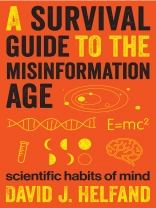We live in the Information Age, with billions of bytes of data just two swipes away. Yet how much of this is mis- or even disinformation? A lot of it is, and your search engine can’t tell the difference. As a result, an avalanche of misinformation threatens to overwhelm the discourse we so desperately need to address complex social problems such as climate change, the food and water crises, biodiversity collapse, and emerging threats to public health. This book provides an inoculation against the misinformation epidemic by cultivating scientific habits of mind. Anyone can do it—indeed, everyone must do it if our species is to survive on this crowded and finite planet.
This survival guide supplies an essential set of apps for the prefrontal cortex while making science both accessible and entertaining. It will dissolve your fear of numbers, demystify graphs, and elucidate the key concepts of probability, all while celebrating the precise use of language and logic. David Helfand, one of our nation’s leading astronomers and science educators, has taught scientific habits of mind to generations in the classroom, where he continues to wage a provocative battle against sloppy thinking and the encroachment of misinformation.
สารบัญ
Foreword
Acknowledgments
Introduction: Information, Misinformation, and Our Planet’s Future
1. A Walk in the Park
2. What Is Science?
3. A Sense of Scale
Interlude 1: Numbers
4. Discoveries on the Back of an Envelope
5. Insights in Lines and Dots
Interlude 2: Language and Logic
6. Expecting the Improbable
7. Lies, Damned Lies, and Statistics
8. Correlation, Causation . . . Confusion and Clarity
9. Definitional Features of Science
10. Applying Scientific Habits of Mind to Earth’s Future
11. What Isn’t Science
12. The Triumph of Misinformation; The Peril of Ignorance
13. The Unfinished Cathedral
Appendix: Practicing Scientific Habits of Mind
Notes
Index
เกี่ยวกับผู้แต่ง
David J. Helfand is the chair of the Department of Astronomy at Columbia University where he has served on the faculty for four decades. He has also been a visiting scientist at the Danish Space Research Institute, the Sackler Distinguished Visiting Astronomer at Cambridge University, and president of the American Astronomical Society. He was a founding tutor and served as president and vice chancellor at Quest University Canada. He has published commentary in Nature, Physics Today, the Globe and Mail, the Washington Post, and the New York Times, among other publications.












